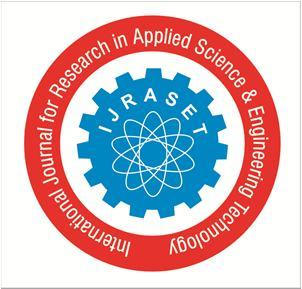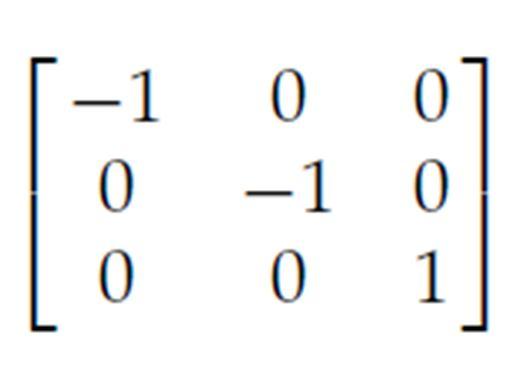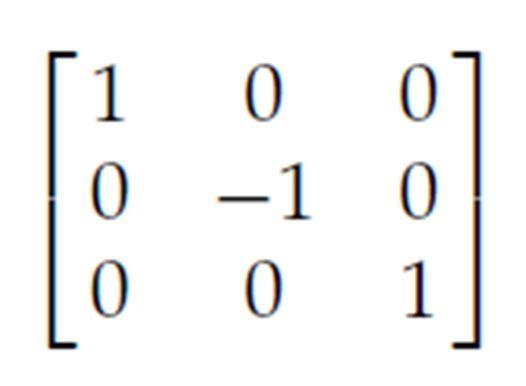
ISSN: 2321-9653; IC Value: 45.98; SJ Impact Factor: 7.538 Volume 10 Issue XII Dec 2022- Available at www.ijraset.com



ISSN: 2321-9653; IC Value: 45.98; SJ Impact Factor: 7.538 Volume 10 Issue XII Dec 2022- Available at www.ijraset.com


Mr. N. Krishna Khanth1, Mr. Sharad Jain2 , Ms. Kanchana Bora3 1, 2, 3MCA, Jagan Institute of Management Studies, India
Abstract: The Research paper contains a brief introduction about 2D reflection or transformation along with the better or less complex algorithm in Computer Graphics. 2D reflection is used for manipulating, repositioning, changing size, rotating and also to get the mirror image of the real-world object which are stored in the form of images in a computer. Suggesting a less complex algorithm to make it easier to understand or for manipulating images more efficiently according to the user needs.
Keywords: Graphics, 2D Reflection, Repositioning
Computer Graphics is the art of drawing, graphs, photographs, maps and more on the computer screen with the help of programming. It involves image creation, manipulation to create 2D and 3D images. Reflection is a process of transforming an object which produces the mirror image. The mirror image can be in any of the axis either x -axis or y- axis. The image can also be rotated by 180°.
1) Reflection about x -axis: In this type, the Y coordinate will remain the same.
2) Reflection about Y-axis: X coordinate will remain the same.
3) Reflection about Axis Perpendicular to the (x, y) Plane and Passing through The Origin: Both X and Y coordinate will remain the same.
Reflection is about the transformation that produces the mirror image of the object. The mirror image of the object is produced by rotating the object at 180 degrees with respect to the reflection axis. The reflection axis can be anywhere in the XY plane. [4]
Proposed algorithm is able to reduce space and time complexity. Algorithm performs reflection on X-axis, Y-axis, and origin as shown in image below. [3]

If the X-axis is the reflection axis, then after the reflection the new coordinates will be: X’=X
ISSN: 2321-9653; IC Value: 45.98; SJ Impact Factor: 7.538 Volume 10 Issue XII Dec 2022- Available at www.ijraset.com

If the Y-axis is the reflection axis, then after the reflection the new coordinates will be:
X’=-X

Y’=Y
If the reflection takes place simultaneously in both X-axis and Y-axis then after the reflection the new coordinates will be:
X’= -X Y’= -Y
1) Implementation of Existing Algorithm in C Programming Language
void multiply(int mat1[][3], int mat2[][3], int res[][3]) { int i, j, k; for (i = 0; i < 3; i++) for (j = 0; j < 3; j++) { res[i][j] = 0; for (k = 0; k < 3; k++) res[i][j] += mat1[i][k] * mat2[k][j]; }



}
void refx(int mat[][3]) { int i, j, i1; int mx = getmaxx()/2, my = getmaxy()/2; int t[3][3] = {{1, 0, 0}, {0, -1, 0}, {0, 0, 1}}; int res[3][3] = {{0, 0, 0}, {0, 0, 0}, {0, 0, 0}}; multiply(mat, t, res); for (i = 0; i < 3; i++) {
}
res[i][0] += mx; res[i][1] = (res[i][1] * -1) + my; mat[i][0] += mx; mat[i][1] = (mat[i][1] * -1) + my; }
for (i = 0; i < 3; i++) { i1 = i + 1; if (i1 > 2) i1 = 0; line(mat[i][0], mat[i][1], mat[i1][0], mat[i1][1]); line(res[i][0], res[i][1], res[i1][0], res[i1][1]); }

void refy(int mat[][3]) { int i, j, i1; int mx = getmaxx()/2, my = getmaxy()/2; int t[3][3] = {{-1, 0, 0}, {0, 1, 0}, {0, 0, 1}}; int res[3][3] = {{0, 0, 0}, {0, 0, 0}, {0, 0, 0}}; multiply(mat, t, res) ; for (i = 0; i < 3; i++) { res[i][0] += mx; res[i][1] = (res[i][1] * -1) + my; mat[i][0] += mx; mat[i][1] = (mat[i][1] * -1) + my; } for (i = 0; i < 3; i++) { i1 = i + 1; if (i1 > 2) i1 = 0; line(mat[i][0], mat[i][1], mat[i1][0], mat[i1][1]); line(res[i][0], res[i][1], res[i1][0], res[i1][1]); } }
void refo(int mat[][3]) { int i, j, i1; int mx = getmaxx()/2, my = getmaxy()/2; int t[3][3] = {{-1, 0, 0}, {0, -1, 0}, {0, 0, 1}}; int res[3][3] = {{0, 0, 0}, {0, 0, 0}, {0, 0, 0}}; multiply(mat, t, res); for (i = 0; i < 3; i++) { res[i][0] += mx; res[i][1] = (res[i][1] * -1) + my;
ISSN: 2321-9653; IC Value: 45.98; SJ Impact Factor: 7.538 Volume 10 Issue XII Dec 2022- Available at www.ijraset.com

mat[i][0] += mx; mat[i][1] = (mat[i][1] * -1) + my; }
for (i = 0; i < 3; i++) { i1 = i + 1; if (i1 > 2) i1 = 0; line(mat[i][0], mat[i][1], mat[i1][0], mat[i1][1]); line(res[i][0], res[i][1], res[i1][0], res[i1][1]); }
ISSN: 2321-9653; IC Value: 45.98; SJ Impact Factor: 7.538 Volume 10 Issue XII Dec 2022- Available at www.ijraset.com

}

1) Approach
Step 1:
Draw a line which will act as a Y-axis and in the line function, pass 4 parameters as line(getmaxx()/2, 0 , getmaxx()/2, getmaxy).
Step 2: Draw a line which will act as an X-axis and in the line function pass 4 parameters like line(0, getmaxy()/2, getmaxx(), getmaxy()/2).
Step 3: Draw an object with the help of a line function with parameters from the set variables.
Step 4: Now execute reflection and draw an object along the origin, make use of step3 and color it any color like Blue, so that it becomes distinguishable.
Step 5: Execute reflection and draw an object along the X-axis, make use of step 1 and color it any different color so that it becomes distinguishable.
Step 6: Execute reflection and draw an object along the Y-axis, make use of step 2 and color it any different color so that it becomes distinguishable.
[1]
2) Implementation of Algorithm in C Programming Language [1]
#include <conio.h>
#include <graphics.h> #include <stdio.h> // Driver Code void main()
{
// Initialize the drivers
int gm, gd = DETECT, ax, x1 = 100; int x2 = 100, x3 = 200, y1 = 100; int y2 = 200, y3 = 100;
// Add in your BGI folder path
// like below initgraph(&gd, &gm, // "C:\\TURBOC3\\BGI"); initgraph(&gd, &gm, ""); cleardevice();
// Draw the graph
ISSN: 2321-9653; IC Value: 45.98; SJ Impact Factor: 7.538 Volume 10 Issue XII Dec 2022- Available at www.ijraset.com

line(getmaxx() / 2, 0, getmaxx() / 2, getmaxy()); line(0, getmaxy() / 2, getmaxx(), getmaxy() / 2);

// Object initially at 2nd quadrant printf("Before Reflection Object in 2nd Quadrant");
// Set the color setcolor(14); line(x1, y1, x2, y2); line(x2, y2, x3, y3); line(x3, y3, x1, y1); getch();
// After reflection printf("\nAfter Reflection");
// Reflection along origin i.e. // in 4th quadrant setcolor(4); line(getmaxx() - x1, getmaxy() - y1, getmaxx() - x2, getmaxy() - y2); line(getmaxx() - x2, getmaxy() - y2, getmaxx() - x3, getmaxy() - y3); line(getmaxx() - x3, getmaxy() - y3, getmaxx() - x1, getmaxy() - y1);
// Reflection along x-axis i.e. // in 1st quadrant setcolor(3); line(getmaxx() - x1, y1, getmaxx() - x2, y2); line(getmaxx() - x2, y2, getmaxx() - x3, y3); line(getmaxx() - x3, y3, getmaxx() - x1, y1);
// Reflection along y-axis i.e. // in 3rd quadrant setcolor(2); line(x1, getmaxy() - y1, x2, getmaxy() - y2); line(x2, getmaxy() - y2, x3, getmaxy() - y3); line(x3, getmaxy() - y3, x1, getmaxy() - y1); getch();
// Close the graphics closegraph();
}
Performance analysis is performed based on space and time complexity. Comparison is done based on Apostrium Analysis.
Following calculations are for single reflection.
Assignment operations = 2 + 2 + (3 * 3) = 13 Summary – 2 variables for loop iteration, 2 (3 * 3) matrices, and 9 assignments for matrix multiplication.
ISSN: 2321-9653; IC Value: 45.98; SJ Impact Factor: 7.538

Volume 10 Issue XII Dec 2022- Available at www.ijraset.com
Arithmetic operations = 3 * 3 * 3 * 2 = 54
Summary – 54 arithmetic operations including multiplication and addition.
Asymptotic Time Complexity = O(1)
Apostrium Time Complexity = 67
Assignment operations = 7
Summary – 7 variables for triangle corners coordinates
Arithmetic operations = 3 * 4 = 12
Summary – 3 corners of triangle and 4 arithmetic operations for each corner.

Asymptotic Time Complexity = O(1)
Apostrium Time Complexity = 19
Proposed algorithm performs significantly better in terms of time complexity. In large scale, proposed algorithm will save considerable amount of time. [2]
Following calculations are for single reflection.
Variables Space = (3 * 3) * 3 = 27
Summary – 3 matrices of (3 * 3) size are required.
Stack Space = O(1)
Asymptotic Space Complexity = O(1) Total Space = 27
Variables Space = 7
Summary – 7 variables to store coordinates of corners of triangle. Stack Space = O(1)
Asymptotic Space Complexity = O(1) Total Space = 7
Proposed algorithm performs significantly better in terms of space complexity. In large scale, proposed algorithm will save considerable number of resources [2]
Here in this paper, we have discussed reflection transformation. Among the various transformation we have discussed reflection. We proposed a new C program for 2d reflection in Computer reflection. It is much easier and less complex than the existing one. Better understanding in academics. More helpful in solving large scale problems.
[1] https://www.geeksforgeeks.org/c-program-to-perform-reflection-of-the-given-2d-image-using-computer-graphics/
[2] Etsuji Tomita, Akira Tanaka, Haruhisa Takahashi, The worst-case time complexity for generating all maximal cliques and computational experiments, Theoretical Computer Science, Volume 363, Issue 1, 2006, Pages 28-42, ISSN 0304-3975.
[3] Pietro S. Oliveto, Carsten Witt, Improved time complexity analysis of the Simple Genetic Algorithm, Theoretical Computer Science, Volume 605, 2015, Pages 21-41, ISSN 0304-3975
[4] Ching L. Teo, Cornelia Fermuller, Yiannis Aloimonos; Proceedings of the IEEE International Conference on Computer Vision (ICCV), 2015, pp. 1644-1652
[5] Foley, Van Dam, Feiner, Hughes, Computer Graphics Principles & Practice, 2000, Pearson

ISSN: 2321-9653; IC Value: 45.98; SJ Impact Factor: 7.538 Volume 10 Issue XII Dec 2022- Available at www.ijraset.com
[6] Chennakesava R. Alavla “Computer Graphics”, PHI Learning Pvt. Limited
[7] D. Hearn & Baker: Computer Graphics with OpenGL, Pearson Education, Third Edition, 2009.
[8] Foley, J.D. & Van Dam, A: Fundamentals of Interactive Computer Graphics.
[9] Rogers & Adams, “Mathematical Elements for Computer Graphics”, McGraw Hill, 1989
[10] John F. Hughes, Andries Van Dam, Morgan Mcguire, David F. Sklar James D. Foley, Steven Feiner, Kurt Akeley, “Computer Graphics Principles and Practice Third Edition”.

